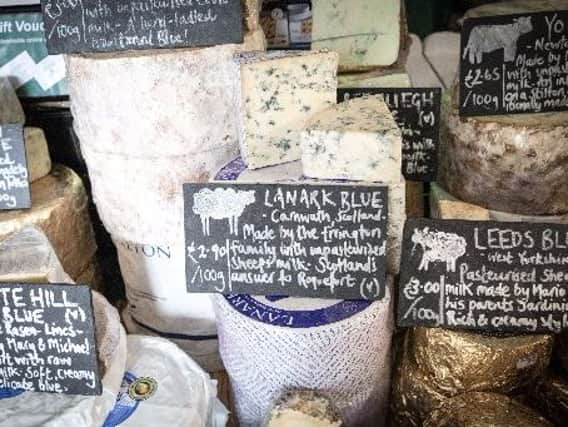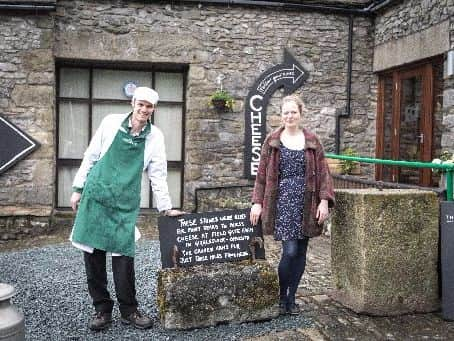Meet the Yorkshire couple who have set up a cheese museum


Five years ago I was invited to the opening of a tiny, specialist cheese shop, just off the A65 on the approach to Settle. The traditional Yorkshire stone shop was no bigger than a small sitting room but inside this space 31-year-old Andy Swinscoe and his wife Kathy unwrapped the story of delicious, British farmhouse cheese.
It was an inauspicious start for a such a small business. But something magical happened when customers crossed the threshold into this charming cheese shop with its handwritten labels and quirky blackboard art. They were offered slivers of delicious cheese which might have tasted creamy, pungent, tangy, rich, woody, leathery or vegetal. The farm cheeses Andy and Kathy stood behind and championed had provenance and tasted so good that customers kept coming back for more and their reputation and business grew.
Advertisement
Hide AdAdvertisement
Hide AdI am now standing in the new Courtyard Dairy, three miles further north along the A65, which has just opened on the site of the former Yorkshire Dales Falconry Centre which Andy and Kathy have transformed into a bigger, more ambitious version of their old business. There is still the original cheese counter but there is also a cafe, a cheese museum and a cheese- making room.


“We had a lot more support for our cheese shop than we ever dreamed of and the business grew to such a point that we realised we could do more with it,” says Andy.
“We have always been keen to set up a museum to tell the fascinating story of British cheese because it so few people know much about it. We also needed more room for our growing mail order business.”
As customers enter the building they are greeted by one of the best cheeses counters in the country – the Courtyard Dairy won Best Cheese Counter at the World Cheese Awards in 2013.
Advertisement
Hide AdAdvertisement
Hide AdGreat wheels of local farm cheese are piled high in an environmentally controlled room which is essential for maturing cheese and keeping it in the best condition. Three, cheerful, enthusiastic women, Debs Procter, Jenny Couch and Louise Pauley, staff the counter. They have been well trained and their knowledge of cheese is impressive.


I ask Andy if the cheese they sell has changed since he opened the first shop.
“We still sell about 30 cheeses which gives enough of a range to have amazing style in each one. Most of our cheeses are British farm cheeses. We pride ourselves on having helped to revive British cheese making. We have played a big role in helping local cheesemakers such as Gillian Clough create her amazing Hebden Goat Cheese from her herd of eight goats over at Hebden Bridge.
“If we had opened our shop 12 years ago there would only have been three British cheeses on the counter today: Kirkhams, Lanark Blue and Devon Blue. People come to us to buy cheese made by a small producer that no one has heard of. We are committed to championing British cheese with a great story. If you want to buy classic European cheese such as Roquefort and Manchego, supermarkets such as Booths and Waitrose do these really well.”
Advertisement
Hide AdAdvertisement
Hide AdUpstairs, in the converted barn, is a charming 30-seat cafe set up by Kathy Swinscoe. Each of the eight tabletops has been made from rare, old wooden cheese maturing boards. These were used to sit cheeses such as Hafford Cheddar, Sparkenhoe red Leicester and Dales End Cheddar on as they matured.
The room is rustic and full of interesting cheese memorabilia such as vintage milk bottles. There is even a glass-fronted maturing room stocked with a selection of whole cheeses waiting to come of age. A raclette grill sits proudly on the counter of the cafe.
“We use the grill to melt an English version of raclette, a cheese which melts beautifully and can be shaved onto a simple dish of new potatoes, white pearl onions and sweet cucumber pickle served with optional locally cured meats,” Kathy tells me as she prepares a dish to sample.
The menu showcases how cheese sold in the shop can be used in simple, tasty dishes including a Ragstone goat’s cheese and roast red pepper grilled sandwich; a Cheddar and beer pot, made from 100 per cent farmhouse cheddars melted into British beer; and a Falconers lunch consisting of a wedge of Drake and Macefield’s pork pie, Dale End Cheddar and Mrs Kirkham’s Lancashire cheese served with artisan bread, sliced apple, celery and piccalilli.
Advertisement
Hide AdAdvertisement
Hide AdDownstairs Andy gives me a tour of the cheese museum which has an impressive range of artefacts including his great-grandmother Mary Reid’s cheese-making notebook from 1912 detailing how to make Double Gloucester, written while she attended the Windsor Dairy College.
There are other cheese-making artefacts including a 19th century cast-iron cheese press and cheese irons used to take samples of the cheese as it matures.
Wall-mounted information boards tell the fascinating story of British cheese from ancient times to the present day.
“Two hundred years ago there were 2,500 farms in Wensleydale each making small amounts of cheese. Each was slightly different as they all had different equipment and made the cheese under slightly different conditions which all has an effect on the taste of the finished product.”
Advertisement
Hide AdAdvertisement
Hide AdNext to the museum is a fully equipped, sanitised, cheese-making room. Andy is keen to share his knowledge of making and ageing cheese and he will be running cheese-making courses from September and has other plans for the future.
“We have 10 spare acres around the Courtyard Dairy which we hope to rent out to a farmer wanting to graze cattle and produce their very own cheese and we are going to convert a warehouse to give us more space to maturing cheese. We also have a little unit we can rent out to an artisan baker or micro brewer.
“We are also hoping to do more work with local schools and get kids involved in learning more about sustainable farming.”
The Courtyard Dairy is located just outside Settle on the A65 heading towards Kendal, in what was the former Falconry Centre (LA2 8AS). Opening hours: Monday to Saturday, 9.30am-5.30pm; Sunday, 10.30am-4.30pm. thecourtyarddairy.co.uk
How cheesemaker’s art has matured over the centuries
Advertisement
Hide AdAdvertisement
Hide AdThe history of cheese-making goes back a long way. Preserved cheese was found in the Taklamakan Desert in Xinjiang, China, in 1615 BC and pictures depicting cheese-making were also found in Egyptian tomb murals dating from around 2000BC.
By Roman times, cheese-making was a mature art and in Pliny’s Natural History he devotes two chapters to the diversity of cheeses enjoyed by those living in the early empire.
The first factory for the industrial production of cheese opened in Switzerland in 1815.
There are over 700 different named cheeses produced in Britain, but Cheddar remains the runaway favourite, accounting for 55 per cent of household purchases. The second most popular is Italian staple Mozzarella – most of which is made in the UK.
Cheshire is thought to be the oldest British cheese. It is even mentioned in the Domesday Book, commissioned by William the Conqueror in 1085.